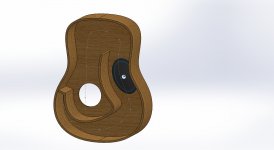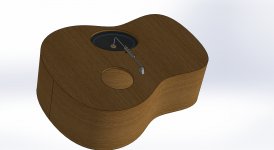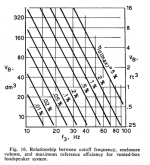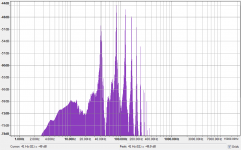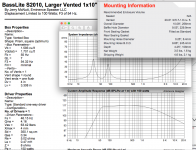Hi everyone,
I have long had an idea of an acoustic bass guitar that sounds real deep and that is comparable to the upright
double bass in loudness.
I understand that it can only be achieved with a reasonably high body, because it is the big volume and mass of
air inside the instrument that gives the required loudness at the lower frequencies.
A couple of days ago I came across the concept of the Tapered Quarter Wave Tube resonator.
So the idea is to have a TQWP and fold it up as a guitar body shape as can be seen on the first attached image.
The driver would be mechanically driven by the resonating bridge, shown on the second image.
The instrument's lowest note would be the same as the double bass's lowest string : E1 (41.2 Hz) and its range
would only be two octaves up to E3 (164.81 Hz)
The tube would be tuned to somewhere around G#1-A1 (51.91Hz-55Hz).
Now my questions are:
1) First of all, is it a good idea at all? I mean, could this folded pipe instrument sound any louder, than a
conventional instrument with a simple hollow body and the top board as the resonator? Assuming the two instruments
had the exact same body volume and the plucking, mechanical energy input is the same in both cases.
2) If yes, how would the bending of the tube affect the sound quality?
3)How precise does the tapering have to be? Does its cross-section area have follow a strict increase along the quarter wave path?
4) Is it possible to completely cut off, or severly supress a frequency band above, say 170-180 Hz by the geometrical modification of such sound box?
Since I am not an expert at all in acoustics, any input/opinion/remark would be greatly appreciated.
Thanks
I have long had an idea of an acoustic bass guitar that sounds real deep and that is comparable to the upright
double bass in loudness.
I understand that it can only be achieved with a reasonably high body, because it is the big volume and mass of
air inside the instrument that gives the required loudness at the lower frequencies.
A couple of days ago I came across the concept of the Tapered Quarter Wave Tube resonator.
So the idea is to have a TQWP and fold it up as a guitar body shape as can be seen on the first attached image.
The driver would be mechanically driven by the resonating bridge, shown on the second image.
The instrument's lowest note would be the same as the double bass's lowest string : E1 (41.2 Hz) and its range
would only be two octaves up to E3 (164.81 Hz)
The tube would be tuned to somewhere around G#1-A1 (51.91Hz-55Hz).
Now my questions are:
1) First of all, is it a good idea at all? I mean, could this folded pipe instrument sound any louder, than a
conventional instrument with a simple hollow body and the top board as the resonator? Assuming the two instruments
had the exact same body volume and the plucking, mechanical energy input is the same in both cases.
2) If yes, how would the bending of the tube affect the sound quality?
3)How precise does the tapering have to be? Does its cross-section area have follow a strict increase along the quarter wave path?
4) Is it possible to completely cut off, or severly supress a frequency band above, say 170-180 Hz by the geometrical modification of such sound box?
Since I am not an expert at all in acoustics, any input/opinion/remark would be greatly appreciated.
Thanks
Attachments
GM, thanks for the graph.
I forgot to mention that the current volume of the guitar body is 91 dm^3 , so it is comparable to the size of the Guitarrón Mexcicano, and the acoustic line length is roughly 1.7 meters, that is the dashed line.
As far as I know the 3/4 double bass's displacement is about 110-120 dm^3, and I was just thinking, that the size could be reduced with 20 something percent with some trick
I forgot to mention that the current volume of the guitar body is 91 dm^3 , so it is comparable to the size of the Guitarrón Mexcicano, and the acoustic line length is roughly 1.7 meters, that is the dashed line.
As far as I know the 3/4 double bass's displacement is about 110-120 dm^3, and I was just thinking, that the size could be reduced with 20 something percent with some trick
I was just thinking, that the size could be reduced with 20 something percent with some trick
You're welcome!
Well, can't beat the graph, but you can 'cheat' in that with the right driver at a 2:1 CR [Sd/2] + 4x power gets an = SPL. The problem then becomes finding a [compact enough] driver with sufficent power handling to do it.
Not saying you can't do it, but don't have the time to research it as I don't keep up with what all's available driver wise.
GM
Isn’t the fundamental like 20db down compared to the 1st harmonic on a bass guitar ?
Thought I read that in a stereophile test cd.
I am not a bass guitar player, but I think they would chime in on not bothering for a flat to 40hz box.
Maybe ask on a guitar forum instead of here.
There are some drivers to tune / f3 of 40hz, probably need 4ft3 though.....
Is 1 driver ok ?
Or do you want more to compete with the main stack ?
Thought I read that in a stereophile test cd.
I am not a bass guitar player, but I think they would chime in on not bothering for a flat to 40hz box.
Maybe ask on a guitar forum instead of here.
There are some drivers to tune / f3 of 40hz, probably need 4ft3 though.....
Is 1 driver ok ?
Or do you want more to compete with the main stack ?
Last edited:
Re the frequency response of a bass guitar, the fundamental can be a lot higher than -20dB depending on the instrument and the players choice of pickup blend & Tone control settings.
Attached is the spectrum of the low E of my Peavey (solidbody) electric bass, both pickups about equal, tone controls all the way up (they're passive so that means not cutting anything), straight into the computer via a soundcard, no bass amps/pedals etc in the signal chain at all.
The fundamental is only -6dB from the 2nd harmonic.
However, most bass guitar amps are not flat all the way to 40, so the net result of instrument plus amp could well be in the ballpark of the -20dB Norman was recalling.
Importantly, the tone of each note is determined to a large extent by the relative balance of the various harmonics, so the OP will need to make sure there is reproduction well above the highest fundamental to account for this - event for a fairly dull bass guitar tone I'd recommend having response up to 800-1kHz at least.
HTH,
David.
Attached is the spectrum of the low E of my Peavey (solidbody) electric bass, both pickups about equal, tone controls all the way up (they're passive so that means not cutting anything), straight into the computer via a soundcard, no bass amps/pedals etc in the signal chain at all.
The fundamental is only -6dB from the 2nd harmonic.
However, most bass guitar amps are not flat all the way to 40, so the net result of instrument plus amp could well be in the ballpark of the -20dB Norman was recalling.
Importantly, the tone of each note is determined to a large extent by the relative balance of the various harmonics, so the OP will need to make sure there is reproduction well above the highest fundamental to account for this - event for a fairly dull bass guitar tone I'd recommend having response up to 800-1kHz at least.
HTH,
David.
Attachments
Thanks, now I am studying the chocked output thing, that GM suggested and also analyzing the bass instruments frequency response graphs, because it seems I need to educate myself more in acoustic physics before I start designing the instrument, I realized.
But I have a theoretical question:
Imagine an airtight banjo, or anything similar, with only one resonator side and without any sound holes.
What would happen to the sound of this instrument if the body was filled with say xenon gas, whose density is roughly 6 times that of air's and the speed of sound in this gas is roughly half of it?
But I have a theoretical question:
Imagine an airtight banjo, or anything similar, with only one resonator side and without any sound holes.
What would happen to the sound of this instrument if the body was filled with say xenon gas, whose density is roughly 6 times that of air's and the speed of sound in this gas is roughly half of it?
Gaborgere,1) First of all, is it a good idea at all? I mean, could this folded pipe instrument sound any louder, than a conventional instrument with a simple hollow body and the top board as the resonator?
2) If yes, how would the bending of the tube affect the sound quality?
3)How precise does the tapering have to be? Does its cross-section area have follow a strict increase along the quarter wave path?
4) Is it possible to completely cut off, or severly supress a frequency band above, say 170-180 Hz by the geometrical modification of such sound box?
5) Imagine an airtight banjo, or anything similar, with only one resonator side and without any sound holes. What would happen to the sound of this instrument if the body was filled with say xenon gas, whose density is roughly 6 times that of air's and the speed of sound in this gas is roughly half of it?
1)Good idea, but impractical. The TQWP works with the driver’s compliance and enclosure resonance. For this to work, the driver would have to have an Fs around 41 Hz, which would be a fairly “loose” compliance, but the pressure of the strings on the bridge would compress the driver until it was at Xmech (the excursion limit) and then it could not move any more than the surrounding wood it is mounted on.
2) The bend would have little effect on low frequency sound quality.
3) The effect of different cross sections can be modeled in David McBean’s Hornresp program, though the transducer’s TS parameters must be entered.
4) Tuned “stubs” , stuffed Helmholtz resonators can be used to suppress narrow band resonances.
5) Assuming you could make it airtight, which would require metal or glass containment the xenon gas would have less effect on the sound than the container materials.
The low frequency output of an acoustic upright bass can be achieved with a body the size of the Guitarrón Mexcicano using a small long throw woofer, and battery powered amp.
Post 52 of this thread has an example:
Self contained electric acoustic u-bass
Art
Art,
So basically we can't really cheat with the body size in the case of a purely acoustic bass instrument, if we want it to produce the same volume as the upright bass?
Actually my original idea was something like the battery-powered semi- acoustic guitar, like the one in the post you linked in.
At the end the goal is to have a contra-bass instrument that isn't suppressed by the other 5-6 higher sounding instruments.
So if I am not mistaken you propose a guitar-shaped guitar combo with an active pick up, the amp circuit and the power supply battery all inside it, like the one the luigiman built?
In this case would you please guide me in the right direction regarding the required calculations that are necessary to calculate some midway between the loudspeaker air volume and the required amplifier power?
Is there some graph/equation that is the cabinet volume vs. required amp powerage to achieve a certain sound pressure level in these low frequency ranges?
Something like: if the body is x liters, and the driver is such and such, it requires y watt of amplifier power to have, say a 95 dB SPL?
Also:
You say that the TQWP works with the enclosure resonance, and it confused me a bit, because someone has built a concrete TQWP:
TQWT Concrete cabinet attempt, building thread.
Thanks,
Gabor
So basically we can't really cheat with the body size in the case of a purely acoustic bass instrument, if we want it to produce the same volume as the upright bass?
Actually my original idea was something like the battery-powered semi- acoustic guitar, like the one in the post you linked in.
At the end the goal is to have a contra-bass instrument that isn't suppressed by the other 5-6 higher sounding instruments.
The low frequency output of an acoustic upright bass can be achieved with a body the size of the Guitarrón Mexcicano using a small long throw woofer, and battery powered amp.
So if I am not mistaken you propose a guitar-shaped guitar combo with an active pick up, the amp circuit and the power supply battery all inside it, like the one the luigiman built?
In this case would you please guide me in the right direction regarding the required calculations that are necessary to calculate some midway between the loudspeaker air volume and the required amplifier power?
Is there some graph/equation that is the cabinet volume vs. required amp powerage to achieve a certain sound pressure level in these low frequency ranges?
Something like: if the body is x liters, and the driver is such and such, it requires y watt of amplifier power to have, say a 95 dB SPL?
Also:
1)Good idea, but impractical. The TQWP works with the driver’s compliance and enclosure resonance. For this to work, the driver would have to have an Fs around 41 Hz, which would be a fairly “loose” compliance, but the pressure of the strings on the bridge would compress the driver until it was at Xmech (the excursion limit) and then it could not move any more than the surrounding wood it is mounted on.
You say that the TQWP works with the enclosure resonance, and it confused me a bit, because someone has built a concrete TQWP:
TQWT Concrete cabinet attempt, building thread.
Thanks,
Gabor
Gabor,Art,
1)So basically we can't really cheat with the body size in the case of a purely acoustic bass instrument, if we want it to produce the same volume as the upright bass?
2)So if I am not mistaken you propose a guitar-shaped guitar combo with an active pick up, the amp circuit and the power supply battery all inside it, like the one the luigiman built?
3)In this case would you please guide me in the right direction regarding the required calculations that are necessary to calculate some midway between the loudspeaker air volume and the required amplifier power?
4)Is there some graph/equation that is the cabinet volume vs. required amp powerage to achieve a certain sound pressure level in these low frequency ranges?
5)Something like: if the body is x liters, and the driver is such and such, it requires y watt of amplifier power to have, say a 95 dB SPL?
6) You say that the TQWP works with the enclosure resonance, and it confused me a bit, because someone has built a concrete TQWP:
1)Correct. Hoffman's Iron Law for loudspeakers, Loud, Low, Small, pick any two, also applies to acoustic instruments.
2) I didn't propose it, but it seems to be your goal in your OP "I have long had an idea of an acoustic bass guitar that sounds real deep and that is comparable to the upright double bass in loudness." other than the some of the instrument's output would be augmented using additional stored power.
3)Speaker sensitivity (output per watt or a given voltage) can be calculated using a variety of simulation programs. Hornresp is an excellent free program that works with almost any type of cabinet design, and provides impedance, output level, and cabinet volume charts. It has “wizards” that can instantly show the tradeoffs between cabinet volume and output volume.
4)I have included an example below of a design that could be incorporated into a Guitarron sized instrument, using a relatively thin and lightweight (3.5 lbs, 1.6kg) neodymium magnet driver. The amplitude response with 100 watts at 40 Hz (just below Low E on a bass guitar) is 105 dB, one watt would produce 10 dB less, or 95 dB.
5) With the example given, the volume (total) is 1.7 cubic feet, about 48 liters. The 40 Hz output could be slightly increased by lowering the Fb (box tuning frequency) from 55Hz to 46 Hz, with a slight decrease in the range from Fb to around 100 Hz.
This example uses larger driver than Luigiman’s bass instrument, because of the increased sensitivity, it would require a fraction of the power to achieve the same output level.
6) By “enclosure resonance”, I meant Fb.
Speaker box material for sound reproduction is generally desired to be non-resonant to avoid “ringing”. Most use bracing to reduce upper resonances without much weight penalty, but using exceptionally heavy materials like concrete, sand sandwich construction is sometimes employed.
For a musical instrument, the upper resonances of light wood are desirable.
Art
Attachments
Art,
To be honest, I learned more from this last reply than in the past few days, trying to gather some theory from here and there..
As a newbie asking beginner's question on an other forum, like for example Stackoverflow I would have been kicked off wihtout hesitation
The next thing is (now with a basic understanding of loudspeakers), to try to make a simulation myself, like the one whose results you attached
And again: thanks very much.
Gabor
To be honest, I learned more from this last reply than in the past few days, trying to gather some theory from here and there..
As a newbie asking beginner's question on an other forum, like for example Stackoverflow I would have been kicked off wihtout hesitation
The next thing is (now with a basic understanding of loudspeakers), to try to make a simulation myself, like the one whose results you attached
And again: thanks very much.
Gabor
Gabor,
I used the Eminence example because it was available with no work other than copying, they have several cabinet designs available on line for almost all their speakers.
Comparing them is a good introduction to speaker simulation, helps to see mistakes when you get started that can make it seem like you have just designed the greatest little sub, then find it was 300 instead of 30 litres..
I used the Eminence example because it was available with no work other than copying, they have several cabinet designs available on line for almost all their speakers.
Comparing them is a good introduction to speaker simulation, helps to see mistakes when you get started that can make it seem like you have just designed the greatest little sub, then find it was 300 instead of 30 litres..
- Status
- This old topic is closed. If you want to reopen this topic, contact a moderator using the "Report Post" button.
- Home
- Loudspeakers
- Subwoofers
- TQWP Acoustic Bass Guitar
